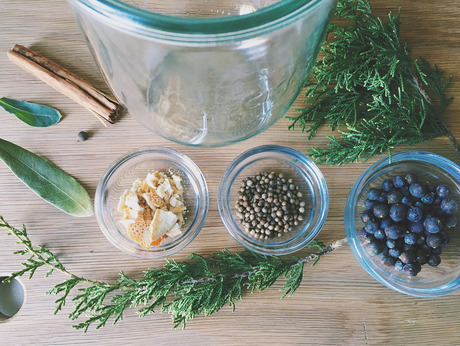Winter Gin recipe + Wild Drinks book giveway
A dear friend recently released a wonderful book and I’m SO excited to be able to share it with you. Emily is my Food Swap Network co-founder and a long-time friend who has served as an inspiration to me for years. You may recall my visit with her in L.A. a couple years back detailed here, here and here.
Her debut book, Wild Drinks & Cocktails, is a total gem. This very informative guide to foraging and wildcrafting all sorts of interesting beverages, both alcoholic and non, is beautifully photographed and packed with amazing recipes. Her years of researching and teaching about these subjects makes this book an essential read for the herbal curious and skilled herbalist alike. The methods and techniques are solidly useful and applicable to any botanicals, aromatics and ingredients you find in your own environment.
Last week Emily and I met up in San Antonio, her hometown, where she was visiting from L.A. We went for a hike and discovered a bounty of juniper berries that were perfectly purple and ripe for the picking. I took home a little basket of berries with festive plans for Emily’s recipe for Winter Gin on the mind.
Emily reminded me that juniper berries have long been used medicinally for kidney stimulation, urinary tract infections, indigestion, inflammation, and for colds and flu. Cheers to your health when you sip this herbal infusion!
***
Winter Gin
NOT everyone loves the fact that gin can taste like a Christmas tree, but as someone who treasures the time she spends in conifer forests, I adore it. And this compound gin embraces the Christmas tree spirit full-on. In it, the juniper berries are infused for longer than they are in the Summer Gin on page 114, then they’re topped with a fragrant sprig of white fir (Abies concolor) and warm, wintery herbs and spices. (If there’s no white fir in your area, substitute another local conifer, such as pine or spruce.) Wrap yourself in a flannel blanket, light the fire in your log cabin, and pour yourself a restorative dose.
2 tablespoons (10 g) juniper berries
1 bottle (750 ml, or 31⁄4 cups) vodka
2 teaspoons coriander seeds
1 teaspoon dried, cut, and sifted orange peel
3-inch (7.5 cm) sprig fresh white fir or 1⁄2 sprig dried
1-inch (2.5 cm) cinnamon stick
1 whole allspice berry
1 dried sage leaf
1⁄2 dried California bay leaf or 1 dried Turkish bay leaf, torn into pieces
Place the juniper berries in a quart (1 L) jar. Pour the vodka into the jar. Cap the jar tightly. Let it stand for 12 hours. Add the rest of the ingredients to the jar, cap it, and let it stand for 36 hours.
Strain the mixture through a fine-mesh strainer lined with a coffee filter or flour sack cloth to remove all fine particles; discard the solids. Bottle and store in a cool, dark place for up to 1 year.
YIELD: 3 1/4 CUPS (750 ML)
NOTE: As with the Summer Gin recipe on page 114, your homemade compound gin will be darker in color than commercial distilled gin; expect it to be yellow or golden.
Wildcrafting Tip: Juniper “berries” are actually little cones—like pinecones—and should be harvested when they’re ripe, having turned from green to dark blue or purple. Not all species of juniper are suitable for consumption. Juniperus communis is the most commonly used species. Avoid savin juniper (J. sabina) and prickly juniper (J. oxycedrus). Research other species before using them in recipes.
***
Emily’s publisher is kindly offering up a copy of the book to HGGH readers, and guess what? They’ll send the book anywhere in the world. Friends from near and far, please do enter! I hope you will enjoy this book as much as I already do.
a Rafflecopter giveawayDisclosures: I received a copy of this book at no cost to me and the winner will receive a copy directly from Fair Winds Press. My opinions about the book are not influenced by this arrangement. There are a couple links to the book above that mean Amazon will deposit a fraction of the proceeds from the sale into my bank account, which helps me continue to run the site and post new recipes and projects. You are welcome to buy the book in any way that makes you happy!
 Alcohol,
Alcohol,  Beverages,
Beverages,  Creative Gifts,
Creative Gifts,  Entertaining,
Entertaining,  Fermentation,
Fermentation,  Flowers,
Flowers,  Foraging,
Foraging,  Garden & Outdoors,
Garden & Outdoors,  Giveaways,
Giveaways,  Herbs,
Herbs,  Kitchen
Kitchen 










Reader Comments (21)
Thank you for your lovely post, Kate. I had so much fun gathering juniper berries together!
I was so inspired by your fruit scraps vinegar lecture at the fermentation festival this year that I came home and started my own. I am looking forward to trying more of your recipes and ideas!
The book looks great! I've been getting into foraging this fall and would love to make some wild drinks.
There are wild huckleberries, plums & blackberries near me. I would love to make something with at least one of them!
luv your recipeis & your give~a~ways! thank you for a chance to win this truly amazing book!
I got a peek at Emily's book and all I want is to drool and swoon over every single page!
We have a ton of pine trees in our yard, each year as the seedlings pop out of the ground, I pick the tiny trees that are no taller than 2 to 3 inches and munch on them. They have an amazingly pure fresh pine taste. This year I hope to harvest a lot of them and infuse a simple syrup with their goodness.
I'm going to make this! Could I use sprigs of juniper rather than white fur?
Looks like a great book!
I am excited to make my own gin! Been dabbling in making liqueurs and bitters this year, so it would be great to make a completely homemade cocktail.
Absolutely Julie, I used a slightly smaller sprig of fresh juniper instead of fir or other pine. Emily suggested if it needs more flavor after sitting with the smaller sprig, then to add more and let it keep infusing! Cheers!
Thanks for the giveaway!
I was looking around to try and figure out solid examples of the juniper that you should not eat [savin juniper (J. sabina) and prickly juniper (J. oxycedrus)] but I am having a really hard time finding a really good way to be sure that the plants near me aren't J. sabina. I am concerned because it is a more suburban area and I know they are planted as ornamental shrubs a lot. But some sources I have read say that the cones are not typically seen on them.
Do you have any suggestions on how to make sure we aren't picking "berries" from these two species?
I am not sure but these recipes would certainly help me decide!
This sounds delicious! I am such a gin lover! A must make!
I'm looking forward to next year's green walnuts. This year I put out a call on the neighborhood facebook group to find someone with a walnut tree I could raid. I made four bottles of nocino, two jars of walnut ketchup, and made cool new friends out of the deal too! I'm also looking forward to picking persimmons. I missed picking them off neighbor trees this year. They aren't "wildcrafting", strictly speaking, but it's still getting me out and exploring the world around me, so I it counts!
Hi Joan,
Although this isn't the only identifying feature, Juniperus sabina will have an unpleasant smell when crushed.
You might take photos and clippings of the plant, including the foliage and any cones or berries, and take it to a garden center or horticulturalist to see if they can help ID it for you.
And if you have some experience in botany and keying out species, here are two resources:
http://www.ruhr-uni-bochum.de/biodivpfl/pdfs/Schulz_2.pdf
http://www.hort.uconn.edu/plants/detail.php?pid=231
Hope that helps!
Looks great! Not too much to find this time of year, but my husband is a fan of pine needle tea!
Really enjoying your blog, thanks for the recipe and awesome giveaway.
Love all the ideas and processes represented here. Thanks for the great giveaway opportunity!!!
Wow! The book arrived in the mail yesterday and it is simply amazing! So much more than I expected it to be! Such a variety of tasty things - combinations I would have never dreamed of but can not wait to taste!
Thank you!